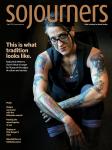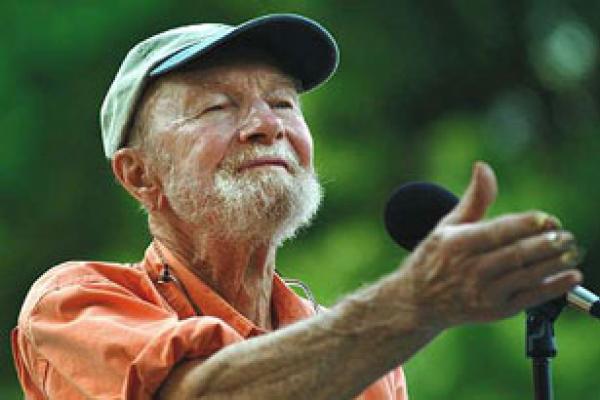WHEN I MOVED out of my Sojourners magazine office in 1988, I took with me two signed review copies of books. One was Roll the Union On: A Pictorial History of the Southern Tenant Farmers’ Union. It was inscribed to me personally by H.L. Mitchell, a founder of the STFU, so I felt entitled to keep it.
The other book bore no inscription, just a simple black ink signature above the Simon & Schuster logo. It was called Carry It On! A History in Song and Picture of America’s Working Men and Women, and the co-author who signed it was Pete Seeger. I’m looking at that signature now, as I write this on the day Seeger died.
I told myself that I kept that book because I thought it might come in handy. After all, it had 11 translations of “L’Internationale” and all the words to “Solidarity Forever.” But really I kept it for the signature. I liked the idea of having something that I knew had come from the hand of someone who had ridden the rails with Woody Guthrie. Seeger was our living connection to the culture of the 1930s when, for a moment, radical dreams about a country owned and operated by its ordinary citizens seemed almost ready for prime time.
Of course, that moment passed, and those dreams were shattered by the Red Scare and the Cold War that followed. But Seeger came out on the other side with his integrity and ideals intact. Despite being honored by the last two Democratic presidents, he never renounced his radical vision of what America could be. Seeger left the Communist Party in the early 1950s and frankly acknowledged that he should have done so sooner, but he never stopped calling himself a “small c” communist. In 1994, he told The Washington Post, “Our ancestors were all socialists: You killed a deer and maybe you got the best cut, but you wouldn’t let it rot, you shared it.” Still, he was a pragmatic radical, who added that socialists should recognize that “every society has a post office and none of them is efficient. No post office anywhere invented Federal Express.”
There aren’t many popular musicians around today who would call themselves communists, and that’s just as well. But you can see the influence of Seeger’s dogged radicalism on subsequent generations when, for instance, you see Neil Young, Willie Nelson, John Mellencamp, and (more recently) Dave Matthews persevere for decades with Farm Aid, dedicated, among other things, to the proposition that the people who work the land should own it and be able to enjoy its fruits. So it was no real surprise last September when Seeger showed up at the Farm Aid show in Saratoga Springs, N.Y., for one of his last public performances.
Seeger’s work as an artist embodied the inclusive, participatory nature of his politics. He was a highly skilled banjo player and, until the past couple of decades, a very good singer. But as a performer, his greatest gift was that of the community organizer: He didn’t just sing for the audience. He got them to sing for themselves.
I had many opportunities to sing in Pete Seeger’s choir: at a nuclear power plant in New Hampshire, in Central Park, and on the National Mall. And I can tell you that when you sang with Pete Seeger you, like Walt Whitman, heard America singing. You heard that abstract idea of democracy become audible and melodic and harmonious. While the music played, you just knew that the power of ordinary people could change history. It was the voice of America—the America that hasn’t quite happened yet, but, as Langston Hughes promised, “America will be.”

Got something to say about what you're reading? We value your feedback!
